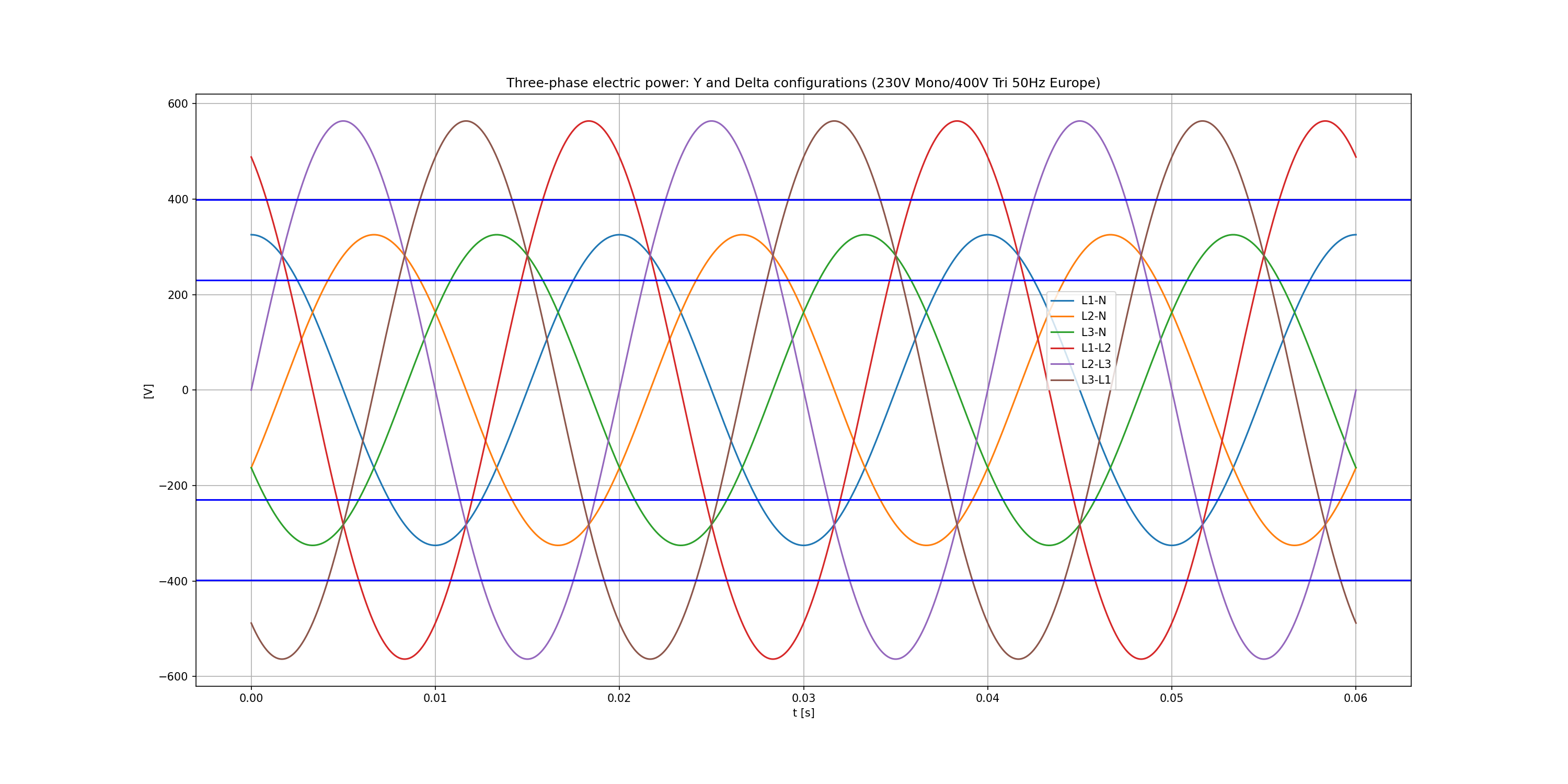####################################################################################################
#r#
#r# =================================================
#r# Three-phased Current: Y and Delta configurations
#r# =================================================
#r#
#r# This examples shows the computation of the voltage for the Y and Delta configurations.
#r#
####################################################################################################
import math
import numpy as np
import matplotlib.pyplot as plt
####################################################################################################
from PySpice.Unit import *
####################################################################################################
#r# Let use an European 230 V / 50 Hz electric network.
frequency = 50@u_Hz
w = frequency.pulsation
period = frequency.period
rms_mono = 230
amplitude_mono = rms_mono * math.sqrt(2)
#r# The phase voltages in Y configuration are dephased of :math:`\frac{2\pi}{3}`:
#r#
#r# .. math::
#r# V_{L1 - N} = V_{pp} \cos \left( \omega t \right) \\
#r# V_{L2 - N} = V_{pp} \cos \left( \omega t - \frac{2\pi}{3} \right) \\
#r# V_{L3 - N} = V_{pp} \cos \left( \omega t - \frac{4\pi}{3} \right)
#r#
#r# We rewrite them in complex notation:
#r#
#r# .. math::
#r# V_{L1 - N} = V_{pp} e^{j\omega t} \\
#r# V_{L2 - N} = V_{pp} e^{j \left(\omega t - \frac{2\pi}{3} \right) } \\
#r# V_{L3 - N} = V_{pp} e^{j \left(\omega t - \frac{4\pi}{3} \right) }
t = np.linspace(0, 3*float(period), 1000)
L1 = amplitude_mono * np.cos(t*w)
L2 = amplitude_mono * np.cos(t*w - 2*math.pi/3)
L3 = amplitude_mono * np.cos(t*w - 4*math.pi/3)
#r# From these expressions, we compute the voltage in delta configuration using trigonometric identities :
#r#
#r# .. math::
#r# V_{L1 - L2} = V_{L1} \sqrt{3} e^{j \frac{\pi}{6} } \\
#r# V_{L2 - L3} = V_{L2} \sqrt{3} e^{j \frac{\pi}{6} } \\
#r# V_{L3 - L1} = V_{L3} \sqrt{3} e^{j \frac{\pi}{6} }
#r#
#r# In comparison to the Y configuration, the voltages in delta configuration are magnified by
#r# a factor :math:`\sqrt{3}` and dephased of :math:`\frac{\pi}{6}`.
#r#
#r# Finally we rewrite them in temporal notation:
#r#
#r# .. math::
#r# V_{L1 - L2} = V_{pp} \sqrt{3} \cos \left( \omega t + \frac{\pi}{6} \right) \\
#r# V_{L2 - L3} = V_{pp} \sqrt{3} \cos \left( \omega t - \frac{\pi}{2} \right) \\
#r# V_{L3 - L1} = V_{pp} \sqrt{3} \cos \left( \omega t - \frac{7\pi}{6} \right)
rms_tri = math.sqrt(3) * rms_mono
amplitude_tri = rms_tri * math.sqrt(2)
L12 = amplitude_tri * np.cos(t*w + math.pi/6)
L23 = amplitude_tri * np.cos(t*w - math.pi/2)
L31 = amplitude_tri * np.cos(t*w - 7*math.pi/6)
#r# Now we plot the waveforms:
figure, ax = plt.subplots(figsize=(20, 10))
ax.plot(
t, L1, t, L2, t, L3,
t, L12, t, L23, t, L31,
# t, L1-L2, t, L2-L3, t, L3-L1,
)
ax.grid()
ax.set_title('Three-phase electric power: Y and Delta configurations (230V Mono/400V Tri 50Hz Europe)')
ax.legend(
('L1-N', 'L2-N', 'L3-N',
'L1-L2', 'L2-L3', 'L3-L1'),
loc=(.7,.5),
)
ax.set_xlabel('t [s]')
ax.set_ylabel('[V]')
ax.axhline(y=rms_mono, color='blue')
ax.axhline(y=-rms_mono, color='blue')
ax.axhline(y=rms_tri, color='blue')
ax.axhline(y=-rms_tri, color='blue')
plt.show()
#f# save_figure('figure', 'three-phase.png')
8.5.1. Three-phased Current: Y and Delta configurations¶
This examples shows the computation of the voltage for the Y and Delta configurations.
import math
import numpy as np
import matplotlib.pyplot as plt
from PySpice.Unit import *
Let use an European 230 V / 50 Hz electric network.
frequency = 50@u_Hz
w = frequency.pulsation
period = frequency.period
rms_mono = 230
amplitude_mono = rms_mono * math.sqrt(2)
The phase voltages in Y configuration are dephased of \(\frac{2\pi}{3}\):
\[\begin{split}V_{L1 - N} = V_{pp} \cos \left( \omega t \right) \\
V_{L2 - N} = V_{pp} \cos \left( \omega t - \frac{2\pi}{3} \right) \\
V_{L3 - N} = V_{pp} \cos \left( \omega t - \frac{4\pi}{3} \right)\end{split}\]
We rewrite them in complex notation:
\[\begin{split}V_{L1 - N} = V_{pp} e^{j\omega t} \\
V_{L2 - N} = V_{pp} e^{j \left(\omega t - \frac{2\pi}{3} \right) } \\
V_{L3 - N} = V_{pp} e^{j \left(\omega t - \frac{4\pi}{3} \right) }\end{split}\]
t = np.linspace(0, 3*float(period), 1000)
L1 = amplitude_mono * np.cos(t*w)
L2 = amplitude_mono * np.cos(t*w - 2*math.pi/3)
L3 = amplitude_mono * np.cos(t*w - 4*math.pi/3)
From these expressions, we compute the voltage in delta configuration using trigonometric identities :
\[\begin{split}V_{L1 - L2} = V_{L1} \sqrt{3} e^{j \frac{\pi}{6} } \\
V_{L2 - L3} = V_{L2} \sqrt{3} e^{j \frac{\pi}{6} } \\
V_{L3 - L1} = V_{L3} \sqrt{3} e^{j \frac{\pi}{6} }\end{split}\]
In comparison to the Y configuration, the voltages in delta configuration are magnified by a factor \(\sqrt{3}\) and dephased of \(\frac{\pi}{6}\).
Finally we rewrite them in temporal notation:
\[\begin{split}V_{L1 - L2} = V_{pp} \sqrt{3} \cos \left( \omega t + \frac{\pi}{6} \right) \\
V_{L2 - L3} = V_{pp} \sqrt{3} \cos \left( \omega t - \frac{\pi}{2} \right) \\
V_{L3 - L1} = V_{pp} \sqrt{3} \cos \left( \omega t - \frac{7\pi}{6} \right)\end{split}\]
rms_tri = math.sqrt(3) * rms_mono
amplitude_tri = rms_tri * math.sqrt(2)
L12 = amplitude_tri * np.cos(t*w + math.pi/6)
L23 = amplitude_tri * np.cos(t*w - math.pi/2)
L31 = amplitude_tri * np.cos(t*w - 7*math.pi/6)
Now we plot the waveforms:
figure, ax = plt.subplots(figsize=(20, 10))
ax.plot(
t, L1, t, L2, t, L3,
t, L12, t, L23, t, L31,
# t, L1-L2, t, L2-L3, t, L3-L1,
)
ax.grid()
ax.set_title('Three-phase electric power: Y and Delta configurations (230V Mono/400V Tri 50Hz Europe)')
ax.legend(
('L1-N', 'L2-N', 'L3-N',
'L1-L2', 'L2-L3', 'L3-L1'),
loc=(.7,.5),
)
ax.set_xlabel('t [s]')
ax.set_ylabel('[V]')
ax.axhline(y=rms_mono, color='blue')
ax.axhline(y=-rms_mono, color='blue')
ax.axhline(y=rms_tri, color='blue')
ax.axhline(y=-rms_tri, color='blue')
plt.show()
